November is coming and, for writers, you may say this is kind of “our season.” November is NaNoWriMo which is National Novel Writing Month. If you’re not familiar with it, this is a competition that is held online every year where all participant writers dedicate their time to writing everyday, starting November 1st to reach the goal of 50, 000 words by November 30th.
And while it has the word “Novel” in it—because that was the idea of the challenge when they started it, creating a novel in 30 days—you don’t necessarily have to write a novel.
It could be a collection of short stories, a non-fiction book of any type, or anything else; the point of this competition is that you develop the habit of writing everyday and, hopefully, also end up with a finished first draft of your project of choice by the end of the month.
There is one way that bloggers can do NaNoWriMo which is to use the writing goal to create content for their blogs. However, if you are like me and happen to be a fiction writer first, and a blogger second, then you will probably wish you could use that month to actually write fiction and not make it all about your blog like every other month of the year probably already is.
I have been away from writing fiction ever since I started this blog, and maybe a little bit before that even, and I wanted to use this November to get back to writing fiction again, but I also find it a bit challenging to write in both directions everyday for 30 days and still manage to hit both goals.
So, in this post, I discuss a few different strategies or tips that can help make this goal happen.
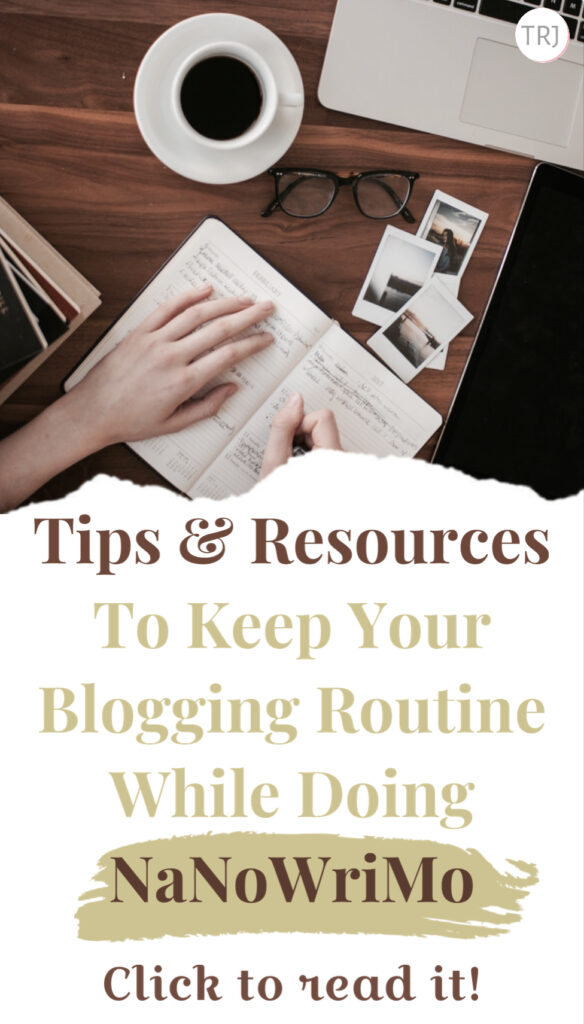
Tips & Resources To Help You Keep Your Blogging Routine While Doing NaNoWriMo:
- Guest posts
- Scheduling posts
- Fixed time per day
- Publish less blog posts
- Finding motivation & inspiration
- Managing time & distractions
1. Guest posts
This probably sounds like the easiest way to manage this and that is if you ask other bloggers to guest post on your blog.
You may go ahead and have that cover the whole month or just publish a number of them to help balance out the amount of time you will have to work on planning the rest of the month’s posts.
You can either post on your social media platforms that you are looking for bloggers to guest post on your blog, or you can personally approach bloggers that you think might be interested and ask them if they would like to publish a post on your blog.
(Speaking of guest posts, I am always looking for bloggers to guest post on this blog, click here if interested.)
2. Scheduling posts
This is kind of the most obvious answer to this situation, and what most bloggers do, and that is to schedule your blog posts for November beforehand, so that through the month of November you just focus on your fiction writing.
However, this option does not exactly work for someone like me, who in most cases needs 5-6 days to create one blog post, and who is preparing for NaNoWriMo only 10 days in advance. . .
If you are like me, then in that case, you can choose to schedule just the topics that you plan to blog about along with bullet points of what will be discussed in that blog post, and may also add any resources or photos that you plan to use, so that the researching and writing becomes more organized and easier to do.
You can just dedicate one or two days for this scheduling process in the next few days, if you haven’t done so already. (We still have time!)
3. Fixed time per day
I shared on Twitter that I was looking for ways to make it easier for bloggers to do NaNoWriMo, and Julie brought this idea to my attention.
What if we just set a specific time per day for NaNo and try to write as much words as we can (umm.. you know, regardless of word count…?). We may set 20, 30, or 60 minutes per day. This way we are participating and writing the stories we wish to put on paper, while still having time to do everything else that we are supposed to do in a day.
This may not sound like the most committed strategy to NaNoWriMo compared to many other writers who literally dedicate every second to the goal, but it will work for someone who desperately wants to participate but can’t seem to find the balance.
On the other hand, Emily Finhill does the opposite, she said she spends a maximum of one hour on her blog per day, and the rest of the free time she has would be dedicated to working on her NaNo project. This also sounds like a practical way to manage both on a daily basis, and puts the focus on NaNo more than the blog.
4. Publish less blog posts
Among the ideas I received on Facebook, Joseph Kavanagh mentioned that he will be participating in NaNo for the first time this year (good luck Joseph!), and while he will try to keep the blogging going, he will be posting less during November to focus on the fiction writing.
I think if you have been posting consistently for a long time, it is okay to shift the focus for just a little bit and rearrange your priorities for that one month.
This can be especially a good idea for bloggers that publish blog posts daily or multiple times a week. Reducing the frequency will make it easier to dedicate more time to NaNo, and your blog will not be completely abandoned, but will certainly cause less pressure.
5. Finding motivation & inspiration
Working on NaNo, for anyone who has more to do in life than just NaNo, means you will need to make use of whatever time you have for writing to write as much as you can.
In order for this to happen, you must have some kind of a plan or a strategy, a way for your brain to start coming up with material to write and not stop until the time is up. And you will need to fight feelings like being uninspired and/or unmotivated to write.
There are a lot of in-depth blogs you can go to read about writing techniques and resources, for sure; however, here I will just share some of the resources that I find helpful or that were suggested to me and I think can be of benefit too.
Read: The Science Of Motivation: Why We Lose It And Where To Find it (17 Tricks To Motivate Yourself)
A. Word sprints
This is one of my favourite writing activities to do during NaNo. For those who are not familiar with the term, word sprint is an activity where you set a timer for any duration you want, it is usually anywhere between 5 and 30 minutes, and write non-stop as many words as you can.
Sometimes, these will also have a certain word or theme that you will try to somehow incorporate into your story or make it inspire a scene/dialogue in the story.
This activity is usually done in groups to elevate the sense of competition and everyone shares the number of words they ended up writing after the time is up, but you can definitely do it yourself as well.
There are many Twitter accounts that do these word sprints in November during NaNoWriMo including of course the official NaNoWordSprints account, where they will run sprints every day throughout the month of November.
You can also search on Twitter for “Word Sprints” and you will find other accounts like this Magical Word Sprints account for all the Harry Potter fans and fantasy writers out there.
Another way you can join word sprints is through this website called MyWriteClub. They allow you to join a global word sprint, meaning to join a random group of people that are currently looking to join one and write together; the sprints start every half an hour and last for 25 minutes.
They also give you the option to create your own group, and there you can add your writer friends and start your own private word sprint. There are more word sprint resources here.
You will be surprised at how much you can write in such a short period of time. And the more you do it, the easier it gets and the more words you can end up with on the screen.
B. Writing groups
NaNoWriMo is based on the concept that we are all one huge group of writers, motivating each other, and are all working towards the same goal. This idea of knowing that you are a part of a group of people, all doing the same thing at the same time can definitely be encouraging and motivating.
It is even more so if you are part of a smaller writing group of people that you can interact with and encourage each other. You can find people in the forums on the NaNoWriMo website (though they revamped the whole thing, and I’m not sure if it is as effective now in connecting with others as it once was).
Also, there is a NaNoWriMo region where you can connect with writers in your own region/country and even meet and have writing sessions in person.
(If you’re in Egypt and haven’t joined the group yet, you will find us in the Pharaoh Wrimos group on Facebook. And if you’re anywhere in Africa, there’s also a WhatsApp group for virtual write-ins!)
You can also go on Twitter and check the #NaNoWriMo2020 hashtag and see who else is joining; start a conversation and see if they would like to be part of an online writing group. Or consider everyone posting in that hashtag as part of your group throughout the month and interact and share your achievements and ask about theirs, and so on.
I almost forgot about Facebook. There are a lot of Facebook groups that you can join to find other writers doing NaNoWriMo, including NaNoWriMo‘s official group.
C. NaNoWriMo resources
Stating the obvious here I know, but you should also make use of the resources on the NaNoWriMo website such as the pep talks they have, which are inspirational and motivational articles or letters written by established writers and published authors for NaNoWriMo participants.
You will find some useful discussions and resources as well in the same forums we just mentioned above.
There is also the NaNo Prep 101, which provides you with different resources and lists of tasks to do every week that prepares you for the competition in November.
And these preparation tasks start in September and all the way to the last week of October.
D. Other resources
These are resources that can help you with the writing process itself, like with plotting and planning, etc.
This blog post explains a plotting technique called Save The Cat which was shared with me by Joana Hill on Facebook. I find this one very helpful in getting your story arc properly set up.
Another suggestion was following Story Genius by Lisa Cron to plotting and planning your project, suggested to me by Angelique Torres. This looks like a really useful book with highly favourable reviews, and it’s already on my to-read list now. Hopefully I will be able to get it within the next few days.
You may also like to check this amazing collection of worksheets put together by Jami Gold and was sent my way by C.J. Ellisson.
I have always been a Panster, so all this planning and plotting is a little overwhelming for me, but I realized I will have to do so if I want to get any writing done this November.
6. Managing time & distractions
The main strategy that will help us pass through this November semi-sane, and hopefully manage to hit our goals as well, is setting up a strict schedule and following through with it.
These are some tools and programs I found that can help you organize your daily tasks, be it your writing goals or any other daily tasks you need to get done, while also assisting you in eliminating the distractions that might stop you from reaching your daily writing goal in time.
A. Writing tools
I love writing tools, and so I always look for ones that are most convenient to use. Beside the common programs you can use to write, like Microsoft Word, Google Docs, Pages, or Scrivener, there is one that I have only come across a few days ago, but I really like the features it offers, and I think I will be using it most of November, and that is OmmWirter.
It creates a very different mood for writing that helps you focus and cancels any distractions with background music and sound effects.
On this program, you can choose from a selection of
- background music pieces,
- writing background images,
- the size of the writing space,
- the kind of the sound effects, such as the typewriter sound it makes,
- and, of course, the font size, type, and colour.
When you are in the writing mode, it goes to fullscreen, blocking everything on your laptop. So no notifications or any type of distractions can divert your attention while writing.
It costs $8.53 and it is available for both Mac and Windows users. You can also test the experience if you want to try it before purchase.
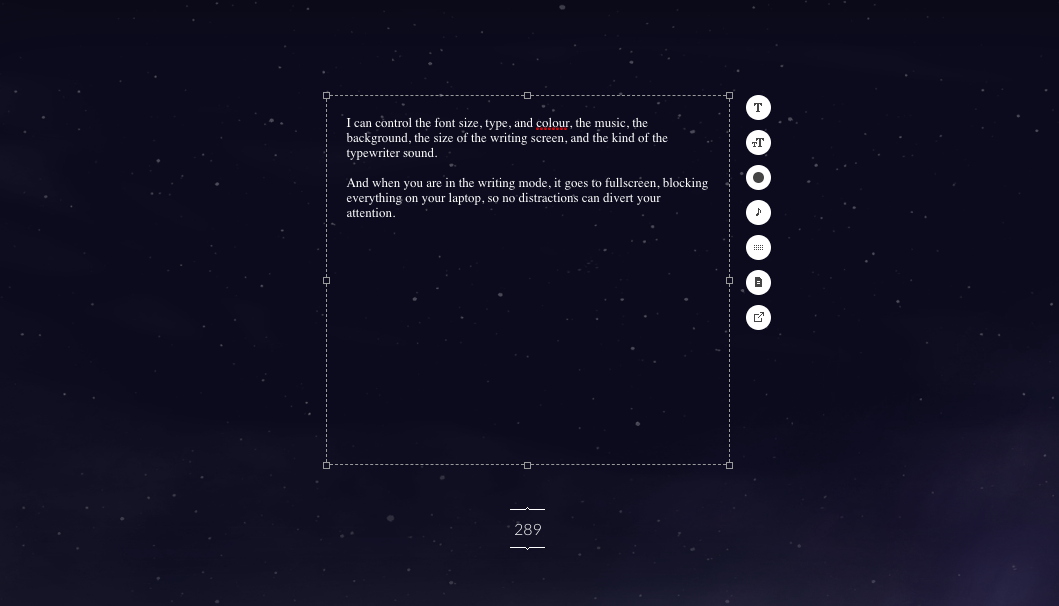
While this software is not exactly the most organized place to create a novel, and you will still need to have something like Google Docs or so, where you will have your full project saved in proper order, this software is great in that it will help you get the words on the page a lot easier.
And here is a list of another 37 writing tools to choose from. You can also check this article if you need some pointers on how to choose the best writing tool for you.
B. Downtime tools
Tools that will help you block distractions on your devices from all the apps and websites by blocking access to them.
For laptops, you can use a free tool like StayFocusd which is an extension for Google Chrome. It helps you “stay focused by restricting the amount of time you can spend on time-wasting websites. Once your allotted time has been used up, the sites you have blocked will be inaccessible for the rest of the day.”
There is also a free version of this tool available for Android users on the Google Play Store, which will also allow you to set time limit for the apps on your phone. You can learn how to set it up here.
If you are an Apple user, there is a built-in feature where you can set a Screen Time limit on your apps and choose which apps that you would like to apply this limit to. Once you have spent that amount of time on those apps, they will be blocked until the next day. You can also set a screen time limit on your Mac by following these steps.
Beside the screen time limit, you can schedule time away from the screen by setting Downtime on your devices which will temporarily disable all apps for a specific number of hours during the day, everyday.
I have been using these features for a while now, since I started a screen time challenge last month, and this has remarkably reduced the amount of time I spend on social media doing absolutely nothing useful.
C. Organization apps
You can set up to-do lists for your main daily and weekly goals in November from now, so that your mind is not distracted by the dozens of things you need to do; you will only follow the lists and focus on the task at hand, and once it’s done, you move on to the next.
MyLifeOrganized is one of my favourite organization apps that I’ve used so far. It is available for most devices; it has versions for Windows and for iOS and Android. (They haven’t developed one for MAC users yet.)
The Windows version is paid-only, but for phones/tablets, it is available for free download, and you can upgrade to have more features, like synchronization with other devices.
The free version is quite useful itself though. It allows you to set unlimited groups of lists on your phone. The thing I love most about it, and that sets it apart from the basic notes app on my phone, is the hierarchy options in setting up lists.
This helps break the goals into smaller ones that you can track and check off the list once done. And that makes tasks feel a lot more manageable.


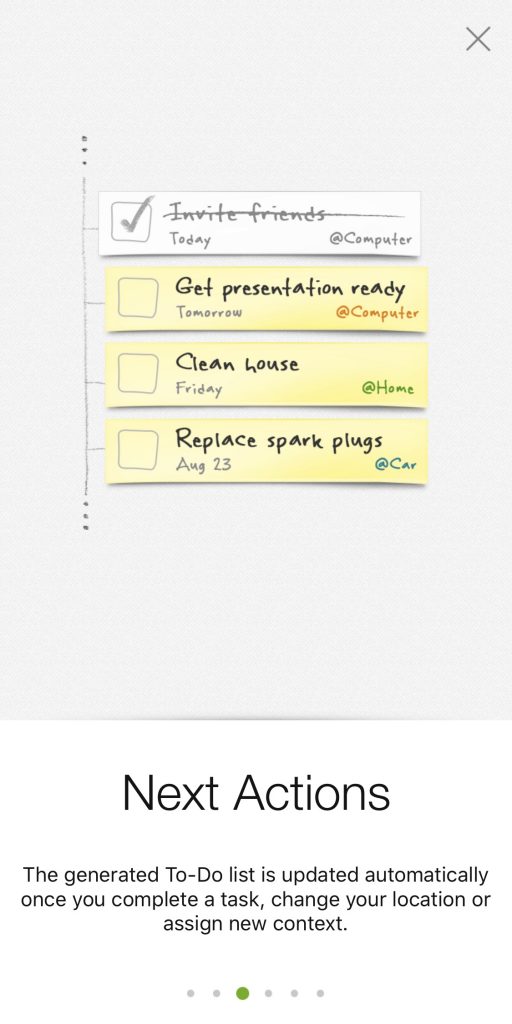

It also has a feature like creating a “Project” where you can add notes, set up a list of subtasks to be accomplished under that project, and setting a time when the project will start, how much time you need to spend on this project every day, and a lot more.
I created one for NaNoWriMo, and I must say it is very helpful. It is like having an overview or a mind map of how I will manage the month.
Another thing I love about it is the different views it has for the to-do lists. For example, if you a have a lot of goals and tasks set up for the month, under several projects, you can choose to view a list of tasks in all projects that are due within, say, the next 3 days only, or tasks that you should start working on within the next 7 days.
They have short video tutorials to introduce the different features available and how to use them on each of the different devices, for iOS, Android, and Windows. Below is an overview for iOS users.
There are plenty of other applications out there though, here is a list of 7 other management tools for writers.
You may also want to check this informative article: NaNoWriMo Success Guide: The habits and routines of the most productive writers. In the article, they list the common habits and routines of writers who reached the 50K goal and won NaNoWriMo last year.
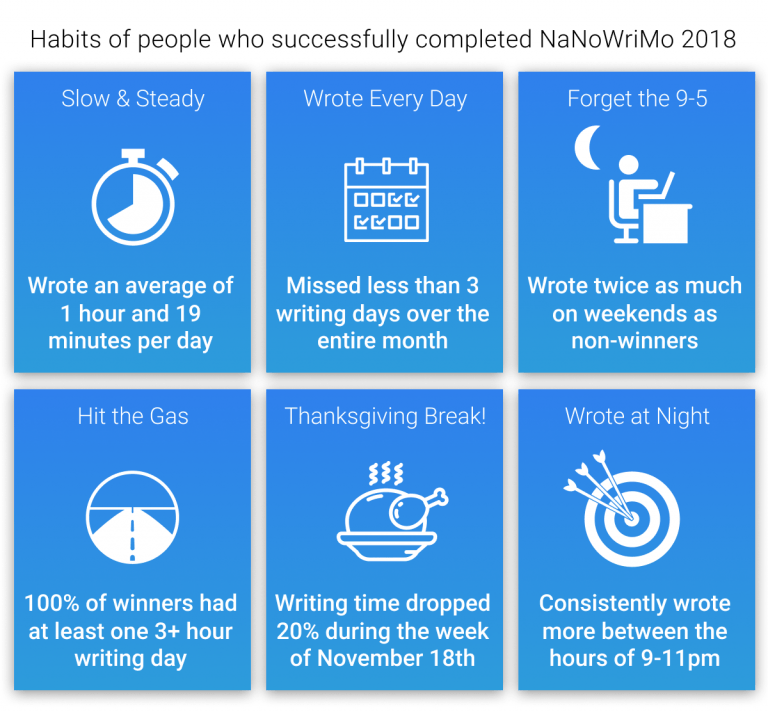
This is everything I can think of right now that should help someone get through NaNoWriMo while blogging and also doing everything else in their life.
Writing this list of tips and resources certainly made me feel that things are going to be a lot more manageable. I hope it does the same for you too.
Recommended Reading: For Writers And Bloggers: A 5-Step Guide To Create, Publish, And Promote Your eBook FOR FREE
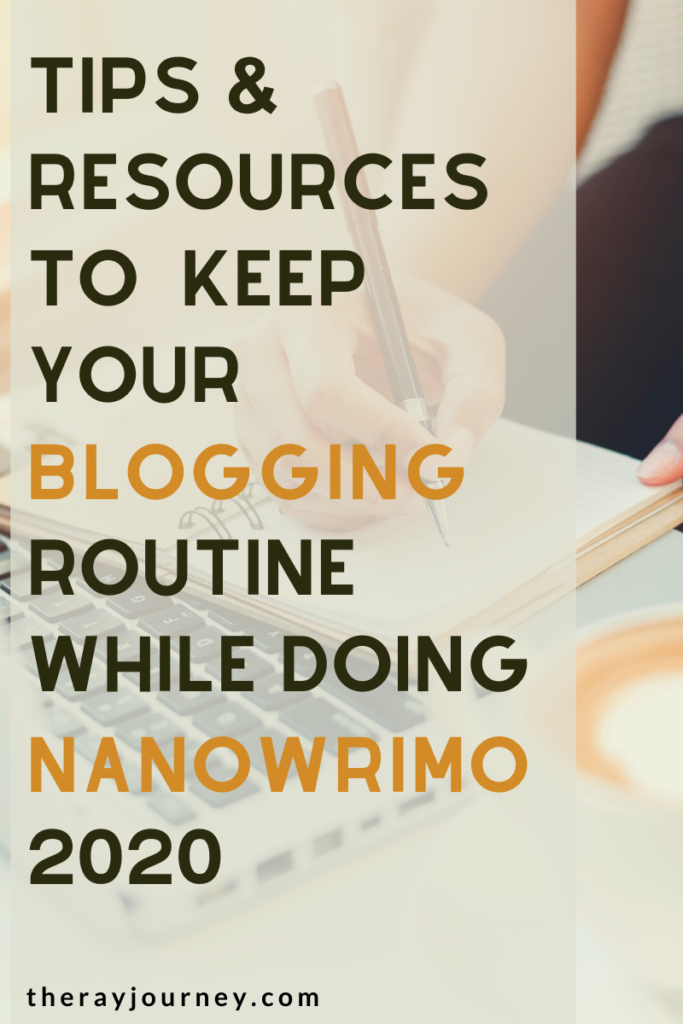
Are you planning on joining NaNoWriMo this year? Have you found any of the tips in this post helpful?
Do you have more tips to share to help manage time and hit writing goals during November? Let me know in the comments below!
Till next week, happy days!





Hey, Ray! I am so glad to be back making rounds in reading my favorite blogs. Life carried me away, but just sitting down and reading a couple of posts has gotten my mind rolling and refocusing in on some of my personal goals. I had never heard of NaNoWriMo either! I will be participating. I started to get that overwhelmed feeling right away as I tried to commit to working on my writing goals and thought about restarting up my blog at the same time. I struggled with just being on top of my blog! I will taking the advice from Emily Finhill. Thanks, Emily! I need to just get the timer working for me. I also will do the word sprints! Thanks as always, Ray. You are the best!
Ah I am glad this post came in time then! You’ve got this, Erin! Happy writing, and thank you for reading. 🙂
This is a great article!
Thank you!
You’re welcome ?
I have always been very keen to get in to fiction writing. I have never heard of this before but I think I will seriously look at it for next year. I’d need to be in a better place with my blog.
I wish you all the luck in the world and look forward to seeing how you get on x
Oh thanks for the well wishes, Claire! I’m going to need it! Haha!
Some bloggers also use this competition to create content for their blogs instead. So you may consider that option too!
I have never written fiction and I have no plans to in the near future, but I still found this post really interesting to read! I’d never heard of NaNoWriMo before (I clicked on this post to find out what it was!) but it was good to check out the writing tools you’ve recommended, as a lot of them could be helpful for blogging too! I like the idea of word sprints too.
Oh wow well I’m so happy I got to introduce you to NaNoWriMo then ? And yes definitely these tools can be useful for blogging as well!
Word sprints are the best! Sometimes they’re also known as Word Wars.. Haha!
I may well use the word sprints (or word wars!) when I am writing blog posts!
Yes, I never thought of doing that with blogging but it is a good idea!
I love this post! I was really hesitant to participate in it because… I don’t like to fail! But reading this post makes me feel a little excited for nanowrimo! I think I’m going to set my own Nanowrimo goal since 50K words on top of blog posts seem a little unattainable. Thanks for this comprehensive collection of resources!
Oh I’m so happy to read that, Julie! You’re more than welcome. I’m sure you’ll do amazing, and I’ll be cheering you on too!! ?